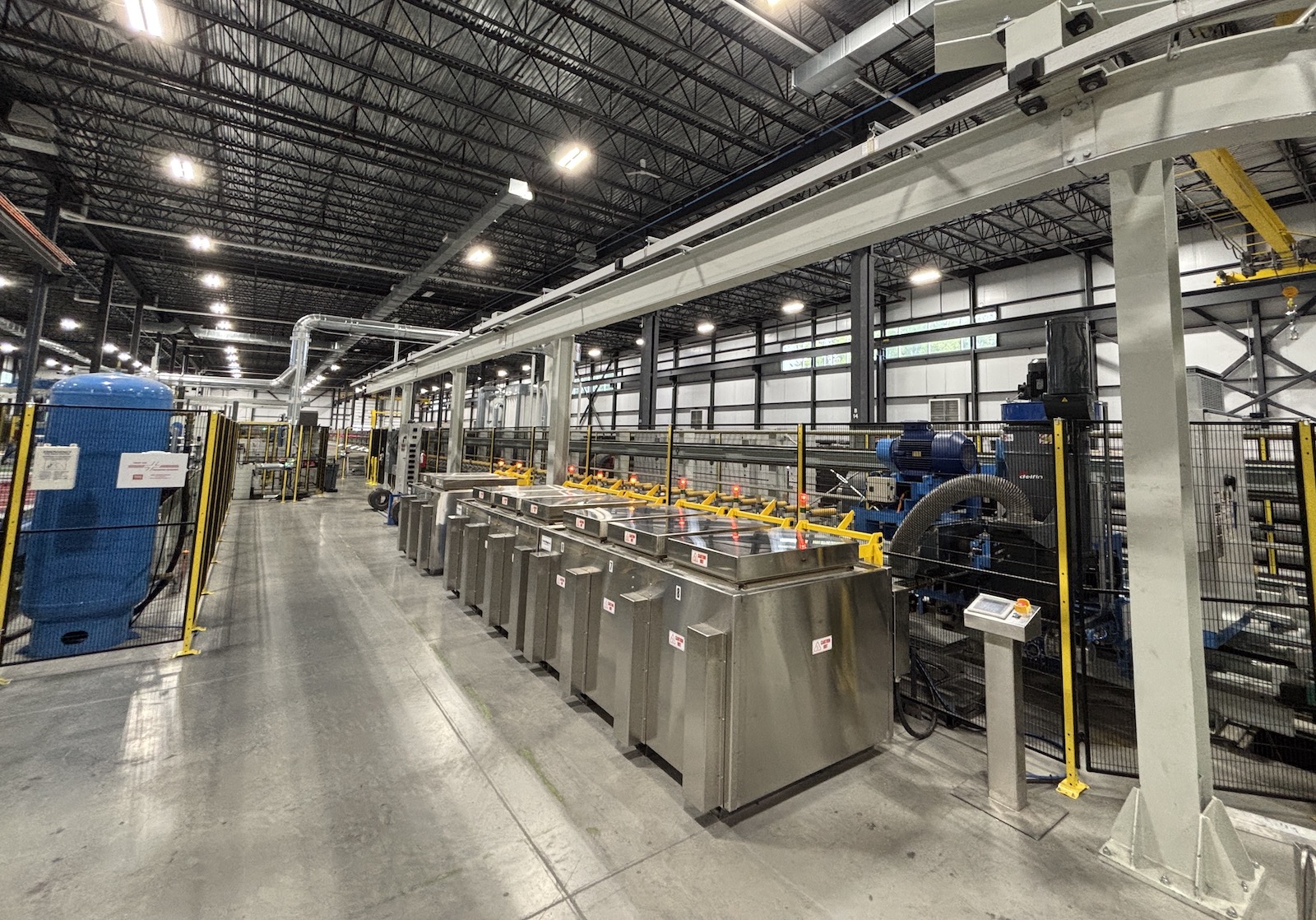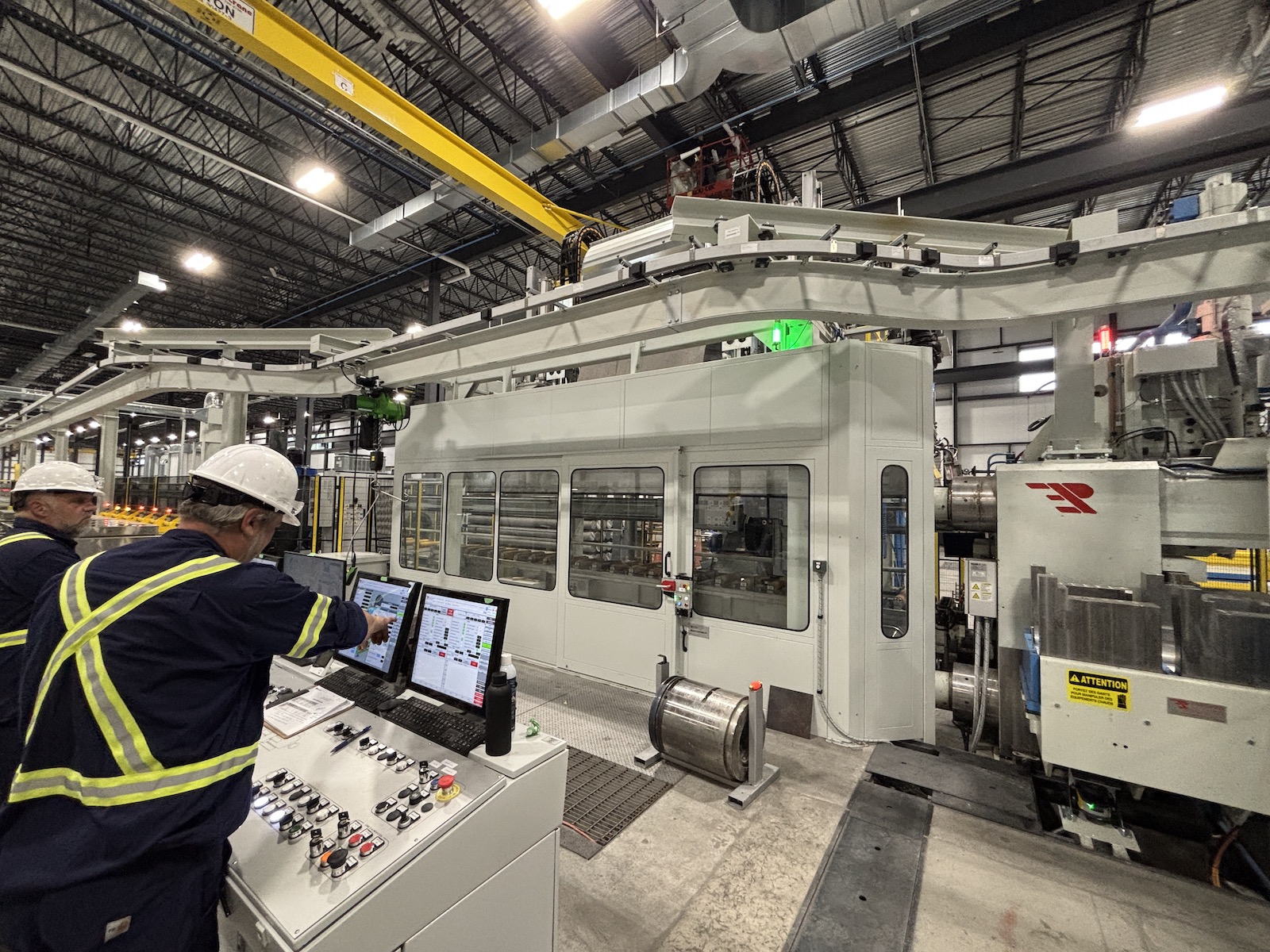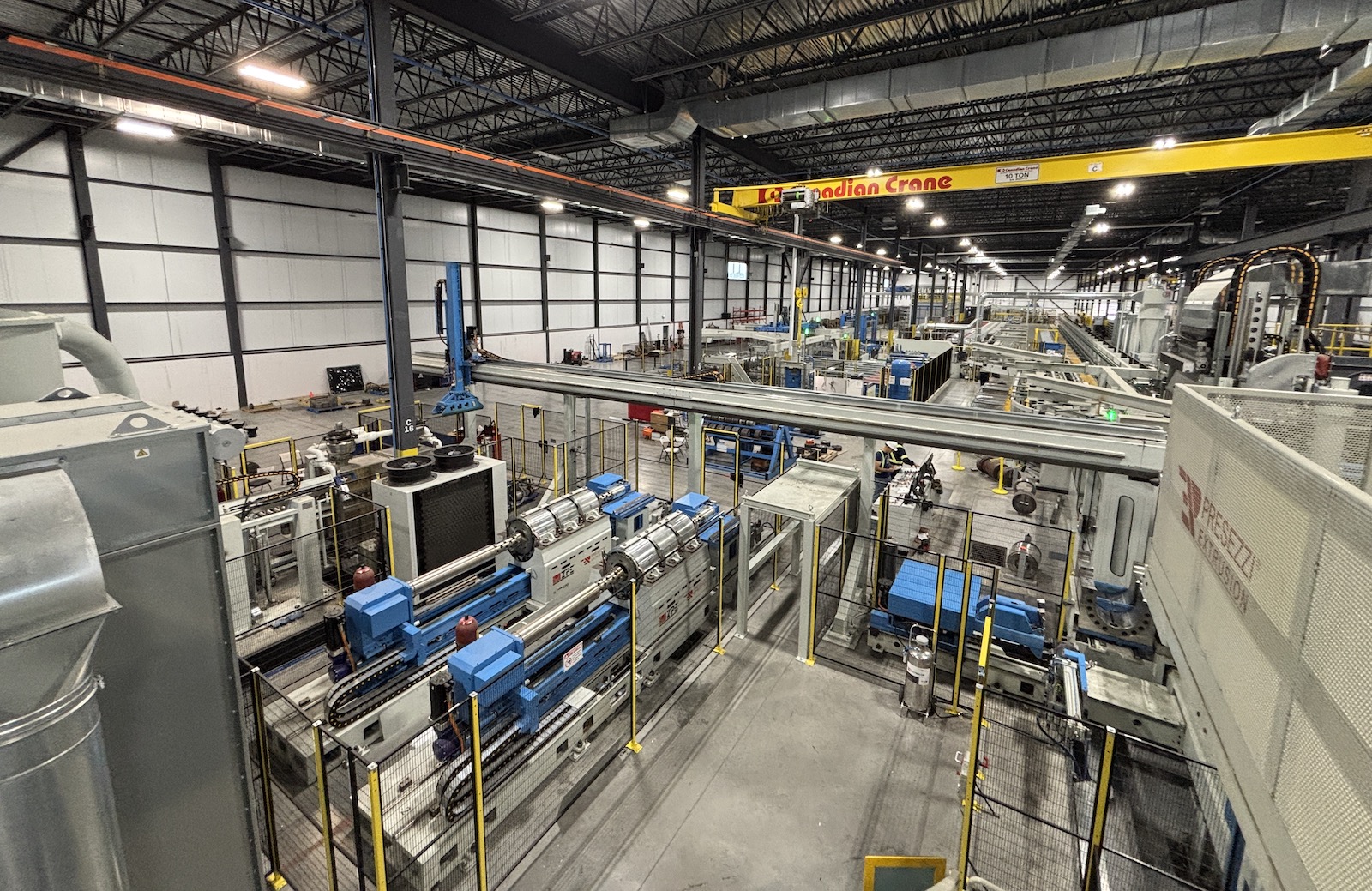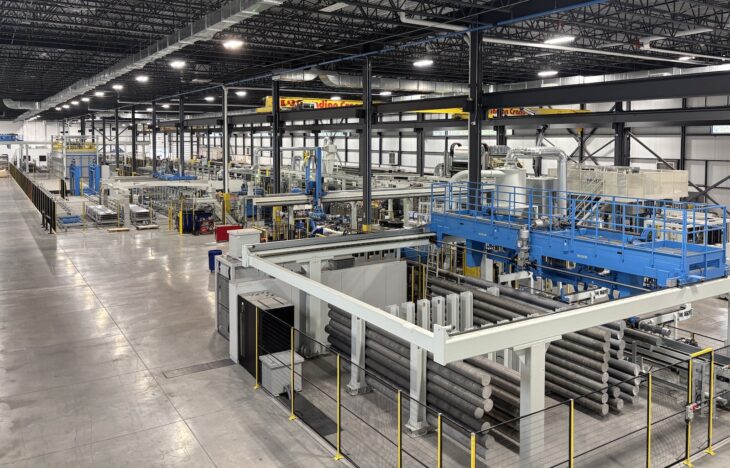By Andrea Svendsen, Managing Editor.
MAGNA Aluminum Profile, a subsidiary of Canadian Specialty Metals, started up operation of its first aluminum extrusion press line at its new facility in Salaberry-de-Valleyfield, Quebec, Canada. The new 9 inch, 28.5 MN extrusion line features a high level of automation and eliminates the use of natural gas in the production process—making it the first extrusion line in North America to achieve fully electric operation.

“The project was a strategic response to the growing demand for aluminum extrusions and increasing concerns over the volatility of offshore supply,” said Nolan Mills (Figure 1), general manager, MAGNA Aluminum Profile. “We needed self-reliance, and this project will prevent the kinds of disruptions in the global supply chain that we felt during the COVID pandemic. It will also allow us to better support the market and ensure reliable service.”
Company Profile
Magna Stainless first began operation in 1982 with a modest 7,000 sq ft facility in Pointe-Claire, Quebec, and later expanded its capabilities in 1988 to include aluminum shapes and alloys. In 1999, the company changed its name to Magna Stainless and Aluminum in-line with its expansion into a 40,000 sq ft facility in Montreal. The company specializes in the distribution of aluminum and stainless steel tubes, flat bars, angles, shapes, I-beams, H-beams, round bars, and square bars, which are used in industries such as construction, transportation, and general manufacturing.
In 2007, the company merged with Canadian Specialty Metals, one of Canada’s leading distributors of stainless steel and aluminum products, which expanded its operational capabilities and increased its product offerings. Canadian Specialty Metals also owns ASA Alloys, a leading distributor of high-quality aluminum, stainless steel, and specialty metals in Canada.
Planning Process
Magna Stainless and Aluminum began planning for the new extrusion facility at the start of 2022, with a focus on selecting a suitable location for the new facility and identifying an extrusion production line that would meet the specific needs of its current market. Salaberry-de-Valleyfield was selected as the location for the new facility for a number of reasons, including its access to clean, affordable energy in the form of hydroelectric power and its proximity to key billet suppliers, such as Rio Tinto and Matalco, ensuring reliable and efficient sourcing of raw materials.
“Salaberry-de-Valleyfield is ideally situated near the Ontario and U.S. borders, with direct access to rail and water routes via the Great Lakes, which enhances transportation flexibility and reduces logistical costs,” said Nolan, who also pointed to the site as an emerging economic hub. “Over the past eight years, the city has evolved into a dynamic economic center in western Montréal. It offers strong support through a skilled workforce, educational institutions, and a network of engaged local businesses and stakeholders.”
When selecting the equipment supplier for the new extrusion line, the company had several key criteria, including a high level of automation, turnkey capability, and sustainability. “As this was our first extrusion line, we prioritized a fully integrated, automated solution from a reputable manufacturer,” explained Nolan. “Following extensive research and evaluation, we selected Presezzi Extrusion Group as our main supplier, and the project received formal approval in July 2023.”
Canadian Specialty Metals ordered the extrusion line from Presezzi in November 2023 and began construction on the building and site works in July 2024. When asked if there were any challenges during the construction and installation process, Nolan laughed and said, “Millions. The only way to overcome them is with patience, communication, organization, and a great, determined team. I like to think of my team as the ‘Incredibles,’ and they continue to advance and innovate each day. We would not be where we are today without them.”
Completion of the new extrusion facility, dubbed MAGNA Aluminum Profile, happened quickly. The new extrusion line was delivered and installed in early 2025, with the first billet being pushed on May 26, 2025 and line commissioning taking place shortly thereafter in August 2025.
New Extrusion Line
MAGNA Aluminum Profile’s new extrusion line is housed in a 100,000 sq ft building. The complete turnkey extrusion line was supplied by Presezzi, featuring a high level of automation and energy saving features. In addition, Thermika Heating Systems supplied the die ovens (Figure 2) and Belco Industries provided the die cleaning equipment.

Prior to the extrusion press, the line includes automated billet storage (up to 80 billets) with full traceability and equipment to cut and wash the billets before they are sent to the Zero Pollution Energy (ZPE) heaters (Figure 3). The ZPE billet heaters are fully electric, eliminating the need for natural gas. They are able to heat the billet to approximately 460–480°C in around 2 minutes, with a temperature accuracy of ±3°C. The quick billet heat times accelerate the start-up process and reduce energy consumption, and the design ensures tapered heating from head to tail of the billet for consistent extrusion temperatures. The ZPE consumes only ±160 kWh per ton of aluminum billet heated.

The 9 inch, 28.5 MN extrusion press (Figure 4) is equipped with Presezzi’s Energy Saving System (PE. E.S.S.), which by incorporating smaller and more efficient pumps, reduces the use of power and oil and lowers energy consumption. The hydraulic pumps are installed in a sound insulated box to reduce noise pollution. The press also features a quick die change capability (under 30 seconds) that minimizes downtime between profile runs, supporting flexible production schedules. In addition, a bolster shear and a butt-end scrap removal were built into the press operation to help improve productivity. Temperature pyrometers (to monitor extrusion temp) and a camera are installed at the press exit to monitor the profiles as they emerge from the press and enter the quench.

The double puller system controls the profiles as they enter the high intensity quench with a sophisticated air-and-water cooling system designed to ensure optimal metallurgical properties and dimensional stability of extruded profiles. The quench also features a profile cooling simulation system to ensure the correct cooling recipe for the profile. A door is installed in front of the quench to protect against heat and noise exposure, as well as preventing entry during automatic mode.
The line also includes a runout table with under-table coolers, a 75 ton automated stretcher, and a layer conveyer for seamless batch changes without bottlenecks. For improved operational flexibility, it also includes a sample saw for quick quality control checks and a cut-to-length table for profiles up to 8 inches high and 7–12 ft (±0.04 inches) or 12–32 ft (±0.12 inches) in length. Following cutting, an automatic stacker and basket lifter is used to streamline post-extrusion handling and reduce labor requirements.
The baskets are automatically loaded into the aging oven, which is another key piece of equipment. Like the log heating furnace, the aging oven is fully electric, removing natural gas from the production process. The oven is designed to handle various recipes for age tempering and ensure the precise specifications of the final profiles. After aging, the baskets are automatically removed from the oven, with a quality control area available to check the profiles as needed. Implementing automatic feeding and discharge of the aging oven ensures consistent thermal treatment and profile quality.
Baskets are automatically unloaded at the packing area, where two semi-automated packaging lines are installed with scratch paper, plastic wrap film, block insertion, and strapping. The packaging lines simplify final product handling and improve packaging speed and accuracy.
The high quality of the profiles is ensured through in-house testing. “We have an in-house lab equipped to conduct testing as per ASTM standards,” explained Nolan. “We have invested in a Zwick Roell tensile and compression tester and a Haas mini mill to ease sample preparation time. We have also installed equipment to run CQI-9 testing on our age temper process.”
Nolan added, “The extrusion line is designed for high speed and is capable of pushing around 4,750 lbs per hour. We are on track, but as with any new line, there are many little ‘gremlins’ on start-up. We’re working them out.”
Future Growth
With the start-up of its new extrusion facility, MAGNA Aluminum Profile is set to produce high-quality extrusion profiles in 6xxx series alloys for the construction, manufacturing and transportation sectors—which will be distributed through Canadian Specialty Metals’ nationwide network of distribution centers. The facility is highly automated and efficient, making it capable of being run with only three operators and a supervisor—and its fully electric design ensures sustainable, environmentally friendly production.
According to Nolan, this is one of the most technically advanced extrusion lines in North America. “For Canadian Specialty Metals, this extrusion line is a strategic asset, which supports high-volume production without compromising quality, enhances product consistency through precise thermal and mechanical controls, and reduces operational costs through automation and energy-efficient systems,” he said. “It also improves our responsiveness to customer demands by providing faster changeovers and flexible batch management with full traceability.”
Moving forward, MAGNA Aluminum Profiles plans to continue being competitive by keeping up-to-date with process technology and innovation, sustainability, and employee training. “This new line will allow us to achieve the quality required [by] many new sectors, such as the automotive industry,” explained Nolan. “We are working with top experts in the aluminum transformation industry to help us build a quality process that will also facilitate requirements of these potential new markets. We have also allowed for space on the premises for expansion as the business grows.”
Editor’s Note: This article first appeared in the October 2025 issue of Light Metal Age. To receive the current issue, please subscribe.

